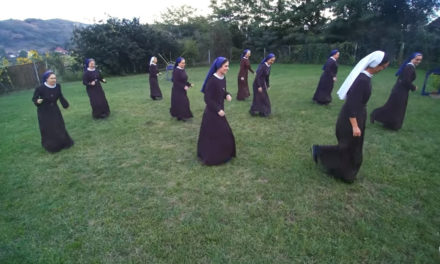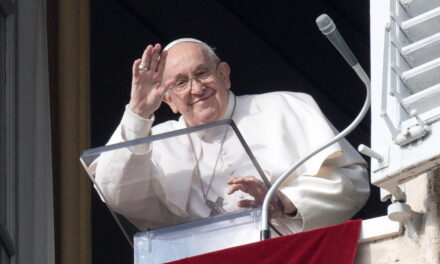Who knows the story of Justo Gallego Martínez? The man who spent 60 years building a cathedral in the town of Mejorada del Campo near Madrid. Basically alone. And here the mind stops and lingers. How can a single person build a building 20 meters wide, 50 meters long and 40 meters high?
From what money? With what knowledge? With what machines?
Justo Gallego Martínez was born on September 20, 1925, as the child of a simple farming family. His mother raised him in the Catholic faith, which was an important factor later on. He was unable to complete his studies because the Spanish Civil War intervened. As a child, he saw priests being shot dead and the church of Mejorada del Campo looted by communist troops fighting Franco's forces. Presumably, this experience is also an important factor later on.
Later, the young man entered the Trappist monastic order and served as a novice in a nearby monastery. In the film, a round-faced father appears, who gives a long account of how much Justo Gallego worked. He liked to work. He just didn't like the (really strict) rules of the order. According to public records, Gallego left the monastery due to illness (specifically, tuberculosis). However, according to the father, this is not true. He had to go because of disobedience. Which is understandable in a way. If someone plays as a member of a team, he cannot go against the spirit and will of the team.
So Mr. Gallego returned to the family land, where he vowed:
when he recovers from his illness, he builds a cathedral in honor of Our Lady of the Pillar. And he was cured.
Come on: out of a million people, nine hundred and ninety-nine thousand and ninety-nine (and maybe I'm underestimating the number) would have thanked God for the blessing and moved on with their lives. However, Gallego acted differently: he started construction on October 12, 1961, the feast day of the Virgin Mary of the Pillar.
Of course, there was a place to build. The family lands were beautiful and large. So he tore a piece out of it and set to work. Well, let's stop here for a moment: Mr. Gallego did not go to architecture university before. He did not even consult at length with various specialists. But he didn't even make blueprints. He just laid the stone and bricks, stirred the mortar, bent the iron, etc.
When asked what he was acting on, he answered: God told me what to do. And after all, he might have been right.
God has such a good architect as Gaudí. Who, by the way, had a very bad opinion of Don Justo, as the locals called him, about his masterpiece. It's a shabby building, he noted bitterly. That is, the Sagrada Família cathedral in Barcelona, which is admired from all over the world.
So we have the answer to one question: Don Justo was not a professional. He just loved to work, in the name of God. But a cathedral requires a considerable amount of building materials. I don't know how much, but it would probably fill a few dozen houses. Where did this Spanish peasant buy so many bricks, cement, beams, and metal? The answer is simpler than we think: the "holy" fool quickly became famous in the countryside. Because, of course, the people thought this blacksmith of the construction trade to be a fool. We usually laugh at such eccentrics, and if the laughter is not enough, we call the person a fool. We also call religious and other ecstasies madness. And sometimes they really do go hand in hand. But perhaps what matters is the intention. And the deed. And in Don Justo, the intention was there. And he acted. He built his cathedral from scrap materials from construction sites in the area, scraps from a brick factory, and sometimes literally from rubble.
If this is not pleasing to God, then what is?
And with this, we also get an answer to the question of where the master builder got his money. From nowhere. Colonies and factories were happy to get rid of garbage. Which was transformed into a house of God day by day, level by level. The method is also highly valued by the experts speaking in the film, who believe that Don Justo was some kind of forerunner of eco-conscious construction from recyclable materials. Not that he cared.
He had one thing to do, namely with the Lord God: to put up the wall, from morning to night
The other question that was running through my mind the whole time while I was watching the story unfold with a good rhythm: ok, I understand, no money was needed to build the cathedral. No knowledge. Just believe. And jobs and days. But there are quite heavy beams and stones. How the hell could one person put them in place? Because according to available information, Don Justo never used a crane, for example. In fact, he needed collaborators from time to time. But who works on a construction site for free? There weren't that many blind believers in the countryside, it soon became clear. When the master builder came up with the solution: he sold or leased the family lands piece by piece. In exchange for work. He also had six people working under him. True, rarely. And it also happened that they cheated our hero. They went to the construction site for a while, then left. However, they kept the land they received. Because that's human nature. Human.
But Justo Gallego Martínez shrugged it off. He understood his neighbors well. He wasn't happy about the scam, but he didn't care either. As I said: he had a job to do.
Who knows how long the work would have gone on if the Coca Cola mega-company had not kicked in Don Justo's door around 2005. They promised a huge sum of money for the refreshing commercial film of Aquarius, which, of course, they wanted to shoot in the cathedral and with the master in the main role. Gallego just turned 80 in 2005. His strength has waned a little. Therefore, after some contemplation and hesitation, he accepted the challenge. Which advertised the soft drink by saying, look how astonishingly wonderful the human being is. (He can even drink Aquarius, I might add.) The commercial brought money to the cathedral. And a crowd of tourists. After all, the earth rarely supports such a fool.
Come on, let's take a photo!
The film shows the rift between Gallego and the world. The tourists who literally invaded the site increasingly disturbed the master builder. Who essentially didn't want a Merc, or yachting, or maniacally clicking locusts. He hid more and more from the public eye. But he continued to work. As long as his hands, arms and legs could handle it. That is until 2020. That is, until the age of 95. When he went to bed. On November 20, 2022, the Lord had mercy on him and called him to himself.
The cathedral is still standing today, protected by local people and organizations, but also by the administration and the church, which previously frowned. That's the movie.
Not the first, and probably not the last, to cover the literally amazing story. When I came out of the cinema, I stopped at the corner of the University and Király utca and wondered: if this one person managed to build a cathedral in sixty years - even if he didn't manage to complete it or make it perfect - then maybe we too have a chance to escape something here, at the ends of Transylvania, for us, who are still a million of us. If not an entire cathedral, at least a shrine. Or an altar. The living example of Don Justo shows: it is possible. All it takes is strong faith.
The entire article of János Szántai can be read on Főtér!
Featured Image: Screenshot













